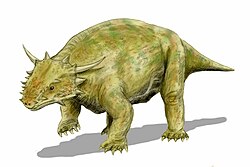| Theledectes Temporal range: Middle Triassic, | |
|---|---|
| Scientific classification | |
| Kingdom: | Animalia |
| Phylum: | Chordata |
| Class: | Reptilia |
| Subclass: | † Parareptilia |
| Order: | † Procolophonomorpha |
| Family: | † Procolophonidae |
| Subfamily: | † Theledectinae |
| Genus: | † Theledectes Modesto & Damiani, 2003 |
| Type species | |
| †Theledectes perforatus (Gow, 1977a [originally Thelegnathus perforatus]) | |
Theledectes is an extinct genus of theledectine procolophonid parareptile from middle Triassic (early Anisian stage) deposits of Free State Province, South Africa.The type species, Theledectes perforatus, is based on the holotype BP/1/4585, a flattened skull. This skull was collected by the South African palaeontologist, James W. Kitching from Hugoskop in the Rouxville District and referred to subzone B of the Cynognathus Assemblage Zone of the Burgersdorp Formation, Beaufort Group (Karoo Basin). The genus was first named by Sean P. Modesto and Ross J. Damiani in 2003. [1] However, the species was initially assigned to the genus Thelegnathus (now considered to be a nomen dubium ) by C.E. Gow in 1977, as the species Thelegnathus perforatus. [2]

